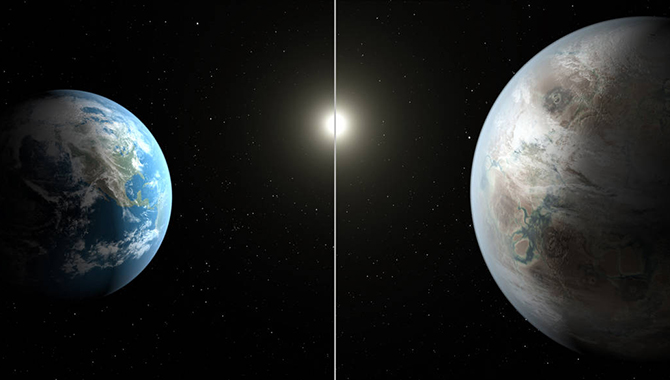
This artist’s concept depicts the Spitzer Space Telescope in space as it points toward Earth to communicate with ground stations.
Image Credit: NASA/JPL-Caltech/T. Pyle (IPAC)
As a prime example of how “clever engineering” can expand project potential, the Spitzer Space Telescope continues to deliver unprecedented data more than 13 years after launch.
NASA recently announced a novel discovery: seven Earth-sized planets orbiting a single star. To examine this system, known as TRAPPIST-1, scientists turned to Spitzer: a space-based infrared observatory that had already made history as the first telescope to spot light from an exoplanet. The Spitzer observatory was an ideal choice for the job because the TRAPPIST star, an ultra-cool dwarf, burns brightest in the infrared.
Spitzer observed the TRAPPIST-1system continuously for more than 20 days, confirming two previously identified planets and spying five additional ones. Three of the planets are in the “Goldilocks” or habitable zone, meaning they orbit their star at a distance that suggests liquid water could exist on their surface. Over the course of its observations, Spitzer’s data enabled scientists to measure the size and mass of six of the planets with enough precision to suggest that at least one habitable-zone planet has a water-rich composition.
The discovery was remarkable—especially for an observatory that was never designed to study exoplanets in the first place.
“We had to do some clever reengineering,” explained Sean Carey, manager of NASA’s Spitzer Science Center at the California Institute of Technology (Caltech)/Infrared Processing and Analysis Center (IPAC) in Pasadena, California. Speaking at a briefing to announce the TRAPPIST-1 findings, Carey said, “We did clever engineering on the ground to allow Spitzer to measure star brightnesses very precisely: a thousand times more precisely than we had imagined Spitzer would be able to do.”
Spitzer identifies exoplanets the same way as the Kepler Space Telescope, which was created specifically to hunt for planets beyond the solar system. Using the “transit” method, Spitzer looks for periodic dips in the brightness of a star that indicate a planet could be crossing in front of it.
“The size of the dip tells you the size of the planet. So we can get the size of the planet directly from measuring the dip,” said Carey. “[E]very time they transit, you can measure the spacing between the transits and that tells you about the…period of the orbit: how long that year is for that planet. And when we know how long it takes for the planet to go around the star, we also know the distance it is from the star. And that also tells us whether or not it’s in the habitable zone.” Spitzer also measures the mass of the planets and, by extension, enables scientists to estimate the density and composition, including whether the worlds are rocky, gaseous, or watery. It captures infrared light emitted by exoplanets as well to investigate their atmospheric compositions.
Spitzer was originally conceived as the infrared component of NASA’s Great Observatories series of space-borne telescopes, which were designed to study the universe across different wavelengths. Because infrared light is essentially heat, to work effectively Spitzer had to keep its instruments as cold as possible. The mission utilized liquid helium to cool the instruments to less than three degrees above absolute zero: -456 degrees Fahrenheit (-271 degrees Celsius). While effective, this approach limited the mission’s life expectancy because the spacecraft was eventually doomed to run out of cryogen. Originally, engineers believed that the liquid helium would run dry in two and a half years. Thanks to an efficient spacecraft design and deft mission operations, Spitzer stayed cold for more than twice that time. By mid-May 2009, however, the coolant was gone.
Two instruments no longer functioned: the Infrared Spectrograph (IRS) and Multiband Imaging Photometer (MIPS). Fortunately, engineers had incorporated a passive cooling system into the spacecraft design, enabling two infrared channels—the shortest-wavelength detectors—on the Infrared Array Camera (IRAC) to continue working under the slightly warmer conditions that could be maintained without coolant: roughly -404 degrees Fahrenheit (-242 Celsius).
A new phase of Spitzer’s life began: the “warm” mission. Engineers and scientists took a number of steps to help the instrument adapt to its new conditions, including recalibrating the telescope and developing a software patch to adjust the temperatures of the arrays around the expected new temperature range. They then conducted a series of tests to determine whether the 3.6-micron array and 4.5-micron array exhibited the same amount of sensitivity as they had previously. Engineers ultimately arrived at an optimal combination of voltage and temperature, which maximized the stability and sensitivity of the infrared array camera and minimized artifacts in the images.
Spitzer officially initiated the “warm” mission on July 27, 2009. Primary activities included further exploring the rate at which the universe is expanding, measuring asteroid sizes to assist with planetary defense activities, and characterizing the atmospheres of gas giants identified by the Kepler Space Telescope. During the subsequent seven years, engineers continued to finds new ways to optimize Spitzer’s performance, such as adjusting the cycling of the spacecraft heater, repurposing one of the cameras, and identifying which pixels and sub-pixels to use to capture the best exoplanet images. Throughout these efforts, the spacecraft remained healthy and functioned nominally.
Over time, however, circumstances changed again. The distance between Spitzer and Earth grew, causing the telescope to experience greater difficulty communicating with ground stations. As a result, it became exposed to more heat—while its solar arrays received less sunlight, putting a strain on the batteries. Engineers went back to work on these new challenges, overriding some of the spacecraft’s autonomous safety systems in order to keep it working. Based on the success of their efforts, Spitzer received another 2.5-year mission extension in June 2016.
Four months later, on October 1, the telescope entered a new era: the “beyond” phase. Once again, Spitzer is surpassing expectations to make observations never thought possible when it launched in 2003. During this new phase, the observatory will examine the black hole at the center of the Milky Way and look far back in time to uncover galaxies in the early universe. Spitzer will also continue to explore exoplanets, helping scientists identify new ones while continuing to penetrate the mysteries of those it has already found. Spitzer is expected to shut down in 2019 following the launch of its successor, another infrared observatory: the James Webb Space Telescope.
Spitzer is operated by the Jet Propulsion Laboratory (JPL), which designed, developed, and implemented the Flight Operations System. Goddard Space Flight Center (GSFC) designed, built, and tested the IRAC hardware. Spitzer’s Science Operating System was designed, developed, and implemented by the Spitzer Science Center (SSC) at Caltech/IPAC. Lockheed Martin designed and developed the Spitzer spacecraft.
Watch a video about Spitzer’s discovery of the TRAPPIST-1 system.
Learn more about Spitzer’s “beyond” mission in this video.
Read an APPEL News article about the Kepler Space Telescope.









